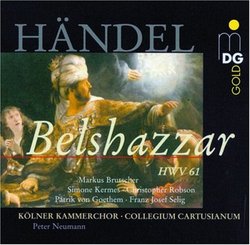| All Artists: Peter Neumann, Markus Brutscher, Christopher Robson, Franz-Josef Selig, Patrick van Goethem, Simone Kermes Title: Handel: Belshazzar, HWV 61 Members Wishing: 1 Total Copies: 0 Label: MD&G Records Original Release Date: 1/1/2001 Re-Release Date: 11/20/2001 Album Type: Box set Genre: Classical Styles: Opera & Classical Vocal, Historical Periods, Baroque (c.1600-1750) Number of Discs: 2 SwapaCD Credits: 2 UPC: 760623107929 |
Search - Peter Neumann, Markus Brutscher, Christopher Robson :: Handel: Belshazzar, HWV 61
 | Peter Neumann, Markus Brutscher, Christopher Robson Handel: Belshazzar, HWV 61 Genre: Classical
|
Larger Image |
CD DetailsSimilar CDs |
CD ReviewsFreedom is eternal, even in slavery Jacques COULARDEAU | OLLIERGUES France | 04/23/2004 (5 out of 5 stars) "1744 and 1745 are bad years for Handel because he is too closely linked to George II and he gets mixed up in political strife. 1745 is also the year of the last and final rising of the Jacobites against the King. It is also the year of the first performing and singing of Rule Britannia ordered by the Prince of Wales. Belshazzar reflects this situation. Handel produces this new biblical oratorio that tries to reconquer success. He uses several means to do so. His music uses a lot more of Bach's tradition, especially fugues. He chooses a subject that is the illustration of the pride of the English to be and remain free : « Britons never will be slaves » Rule Britannia sings. Here it is the story of the liberation of the Jews from Babylon and their final victory with the recognition of their God as being the only one by Cyrus. We can easily see how the Jacobites are projected into Belshazzar and the King into Cyrus. It is clear in aria 36 in which Belshazzar sounds nearly French and we know the Jacobites, and the Stuarts, were always considered as linked to France. On the other hand the Jews in chorus 27 sound Bohemian and even maybe Slavonic in their lament, central European at least, and we know George II was German. At the same time Handel uses all his musical power to produce an oratorio that goes beyond the austere Bach tradition. He uses instruments, orchestra and melodies to characterize the various characters and oppose them. Belshazzar appears like a vain brainless overgrown boy and his singing, his voice, a tenor, fits very well, whereas Daniel is a profound and wise bass, Nitocris a poignant and powerful soprano, and Cyrus a heroic and brilliant alto. In the same way he characterizes very well the three choruses. The Babylonians sound excited but also vain and short-sighted, definitely self-satisfied and condescendent. The Jews express their suffering in a dirge that can become a powerful conviction and faith in the future. The Persians and Medes are on the other hand optimistic, sure of their victory and in no way aggressive or dominating, just human, humane and sensible. On another level, though his oratorio is definitely and heavily Biblical, full of the power of God, of the prediction of the future by God through the Prophets, the only one to take decisions about what humanity, or rather the anointed people, can do and become, Handel emphasizes good sense and intelligence in Cyrus by depicting the fall of Babylon in precise details that reveal the intelligence of the man, his tactics and his strategy, and after the battle, his forgiveness and humanity : war is only directed against the tyrant and not against the people. After the war the victor has to pardon the vanquished, and the people are not teh vanquished actually. So, even if we can see an attempt here to please the public that had been alienated somewhat by his Irish period and by his close links with the King, Handel remains himself, extremely creative, expressive and attached to freedom. He is a man of his time, of the time of the Enlightenment. A rich and beautiful oratorio.Dr Jacques COULARDEAU"
|

 Track Listings (18) - Disc #1
Track Listings (18) - Disc #1